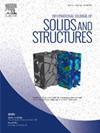Effect of path-dependent plasticity on springback in reverse bending and its application to roll forming
IF 3.4
3区 工程技术
Q1 MECHANICS
International Journal of Solids and Structures
Pub Date : 2024-09-28
DOI:10.1016/j.ijsolstr.2024.113079
引用次数: 0
Abstract
This study investigates springback behavior in martensitic advanced high-strength steels (AHSS) undergoing pure bending and reverse bending sequences. The comparison between a conventional isotropic hardening model and the Homogeneous Anisotropic Hardening (HAH20) model had been made, which accounts for non-isotropic hardening effects. Both models were calibrated using uniaxial tensile, cyclic, and loading–unloading tests. The results show that the HAH20 model predicts a higher initial springback compared to the isotropic model. However, reverse bending significantly reduces the overall springback for both models due to a minimized recovery moment. In scenarios with reverse bending, a specific strain exists where both models predict identical springback due to the secondary Bauschinger effect in tensile stress. This phenomenon is also observed in roll forming, a sequential bending process that incorporates reverse bending steps. Experimental findings from roll forming confirm a decrease in springback after the reverse bending stage. Furthermore, the study explores the impact of non-isotropic hardening on the part crashworthiness with the calibration of cross-loading effects. The Bauschinger effect and cross-loading contraction were found to reduce the maximum crash load by 6.2%.
路径依赖塑性对反向弯曲回弹的影响及其在滚压成形中的应用
本研究调查了马氏体高级高强度钢(AHSS)在纯弯曲和反向弯曲序列中的回弹行为。比较了传统的各向同性硬化模型和考虑了非各向同性硬化效应的均匀各向异性硬化(HAH20)模型。使用单轴拉伸、循环和加载-卸载试验对两种模型进行了校准。结果表明,与各向同性模型相比,HAH20 模型预测的初始回弹较高。然而,由于恢复力矩最小,反向弯曲大大降低了两种模型的整体回弹。在反向弯曲的情况下,由于拉伸应力的二次鲍辛格效应,两种模型预测的回弹都相同。这种现象在滚压成形中也能观察到,滚压成形是一种包含反向弯曲步骤的连续弯曲工艺。滚压成形的实验结果证实,反向弯曲阶段后回弹会减少。此外,该研究还通过校准交叉载荷效应,探讨了非各向同性硬化对零件耐撞性的影响。研究发现,鲍辛格效应和交叉载荷收缩可将最大碰撞载荷降低 6.2%。
本文章由计算机程序翻译,如有差异,请以英文原文为准。
求助全文
约1分钟内获得全文
求助全文
来源期刊
CiteScore
6.70
自引率
8.30%
发文量
405
审稿时长
70 days
期刊介绍:
The International Journal of Solids and Structures has as its objective the publication and dissemination of original research in Mechanics of Solids and Structures as a field of Applied Science and Engineering. It fosters thus the exchange of ideas among workers in different parts of the world and also among workers who emphasize different aspects of the foundations and applications of the field.
Standing as it does at the cross-roads of Materials Science, Life Sciences, Mathematics, Physics and Engineering Design, the Mechanics of Solids and Structures is experiencing considerable growth as a result of recent technological advances. The Journal, by providing an international medium of communication, is encouraging this growth and is encompassing all aspects of the field from the more classical problems of structural analysis to mechanics of solids continually interacting with other media and including fracture, flow, wave propagation, heat transfer, thermal effects in solids, optimum design methods, model analysis, structural topology and numerical techniques. Interest extends to both inorganic and organic solids and structures.

 求助内容:
求助内容: 应助结果提醒方式:
应助结果提醒方式:


